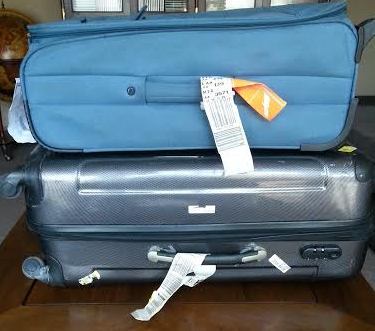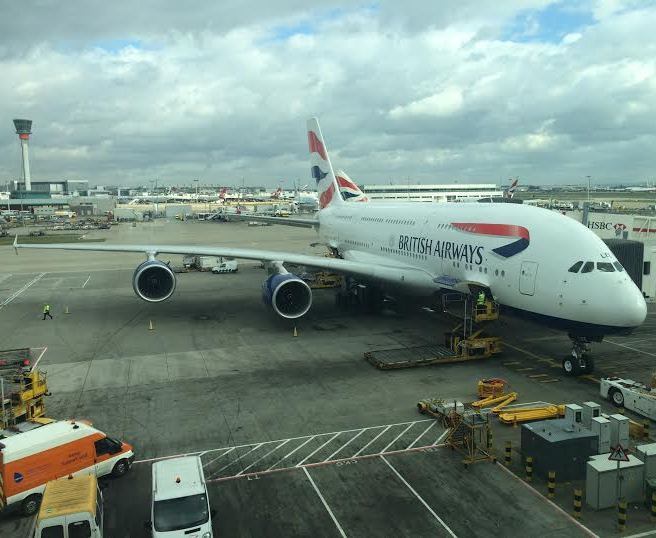Travel News
Moving To Paradise: Life In The U.S. Virgin Islands
 Who hasn’t dreamed of leaving behind everyday life to move to a tropical island?
Who hasn’t dreamed of leaving behind everyday life to move to a tropical island?
Well, Karen Elowitt did just that when she packed up and moved to St. Thomas in the U.S. Virgin Islands.
Read on to learn what it’s like to acclimate to life on the islands, one mosquito at a time.
At some point in time, usually while in the throes of a blissful tropical vacation, nearly everyone has fantasized about packing it all in and moving to paradise.
I have to confess that I was one of those people. After every trip to the Great Barrier Reef, the Greek Islands, or Hawaii, I longed to live a carefree existence in a place where I could feel the sand between my toes every day, and wake up to the sound of waves crashing outside my window.
 So when I was recently offered the chance to spend several months living in the U.S. Virgin Islands, I was surprised that my initial euphoria soon gave way to a tempered caution.
So when I was recently offered the chance to spend several months living in the U.S. Virgin Islands, I was surprised that my initial euphoria soon gave way to a tempered caution.
After all, when you’re on vacation you’re living in a state of unreality, where worldly problems such as bills, babysitting, and traffic don’t exist. Maids clean up after you, you can have margaritas for breakfast, and everything you need can be crammed into a single suitcase.
But whether I could actually live a normal day-to-day existence in the Caribbean was a big question mark. Would I love such a place as the Virgin Islands the same as a full-time resident as I did as a visitor, or would the “sun, sand and surf” allure soon wear off to be replaced by mundane reality?
I figured the only way to know would be to dive right in, metaphorically speaking. So I bought myself a one-way ticket to St. Thomas. Here are my reflections on becoming acclimated to life in paradise.
Residential Realities
My first inkling that living in paradise would be no vacation fairy tale was when I arrived at my apartment, which I had rented in advance, sight unseen. The landlady had assured me over the phone that it was only a short walk to the bus stop, and that all utilities except electricity were included. I figured I could live with that.
When I arrived, I learned that it was in fact an easy downhill walk TO the bus stop, but getting BACK to the apartment would require walking 10 minutes straight uphill. (When it’s 85 degrees out with 90 percent humidity, this is not much fun.)
After a few days of trudging uphill with heavy groceries and other supplies, I cursed St. Thomas’s hilly terrain and vowed to get a car as soon as possible—or move to St. Croix, where apparently it’s much flatter!
But then I started losing weight. A lot of it. So I postponed the idea of moving or getting a car for while. I am nothing if not vain, after all.
I also discovered one of the other advantages of living on a hill: the spectacular views.
Learn more in our complete Caribbean Travel section
 As I settled down on my patio to watch the sunset the first night, glorious rays of red, blue and gold shimmed over the horizon and the lights of Charlotte Amalie twinkled quietly in the foreground.
As I settled down on my patio to watch the sunset the first night, glorious rays of red, blue and gold shimmed over the horizon and the lights of Charlotte Amalie twinkled quietly in the foreground.
“This whole plan to move to the Caribbean was pretty smart,” I though to myself, as I drifted into sleep to the sound of a gentle breeze rustling the palms, and the cruise ships booming their horns as they slowly glided out of the harbor. “I’m in a place that 95 percent of Americans would love to be in right now.”
But after waking up the next morning with over two dozen mosquito bites, I was again not so sure.
Living in the Caribbean involves co-existing with all manner of creatures, I learned, and not just mosquitoes. In my first week I found a frog in my shower, a small snake under the couch, several giant iguanas sunning on the patio, and beetles the size of cell phones crawling up my window screens.
So I developed a pre-bedtime ritual that involved inspecting every nook and cranny of my apartment to make sure no creatures were present, then bathing my exposed parts in insect repellent.
Another island hotspot is Jamaica. Check out:
- Culinary Adventures: Jamaica’s Roadside Food (With Recipes!)
- Laid-Back Caribbean Travel: Jamaica’s Southwest Coast
- Peter Greenberg’s Hidden Gems Jamaica
 Having mastered the arts of insect avoidance and efficient hill-climbing, I then had to learn about residential utilities. My upstairs neighbor, who was originally from Philadelphia, had moved to the island about four years earlier and gone through her own learning curve then. So she was more than happy to fill me in on the basics.
Having mastered the arts of insect avoidance and efficient hill-climbing, I then had to learn about residential utilities. My upstairs neighbor, who was originally from Philadelphia, had moved to the island about four years earlier and gone through her own learning curve then. So she was more than happy to fill me in on the basics.
Things we take for granted in the mainland, she said, like trash pickup and mail delivery, don’t really exist on St. Thomas. Due to the steep hills and narrow roads, large vehicles can’t drive in residential neighborhoods. So you have to take your own trash to the dumpsters on the main road, and nearly everyone has a box at their nearest post office. I contemplated exactly how I would accomplish these errands without a car, but my brain started to hurt.
Electricity, water and gas are another matter entirely. Electricity is the only utility that is actually supplied by the city, but at exorbitant rates and with questionable reliability. I found out that blackouts occur at the rate of about one a week, which is not great if you’re dependent on a computer and modem to make a living.
Natural gas comes in a removable tank that needs to be re-filled every couple of months, and water is collected by a rainwater cistern and disposed of via septic system. This all sounds very eco-friendly, but there are drawbacks: you have to watch your water usage carefully so you don’t deplete your cistern, and if the power goes out, so does the septic pump. So the moral of the story is: don’t use the toilet during a blackout. Makes sense, right?
 Even my own address was a source of confusion. In the town center, addresses are done the North American way, with a number and a street name. But in residential areas outside the town center, houses are numbered based on what “estate” they are located in (i.e. Estate Donoe, Estate Bordeaux). The estates are a holdover from the sugar plantations of the 17th and 18th centuries.
Even my own address was a source of confusion. In the town center, addresses are done the North American way, with a number and a street name. But in residential areas outside the town center, houses are numbered based on what “estate” they are located in (i.e. Estate Donoe, Estate Bordeaux). The estates are a holdover from the sugar plantations of the 17th and 18th centuries.
For some reason they never switched over to modern address conventions, even after the U.S. bought the Virgin Islands from the Danish in 1917. Perhaps they decided not to bother, since the mail carriers don’t deliver there anyway.
Instead they just assigned house numbers to all the buildings in the estate, in semi-geographic order. For example, 1 Estate Bakkeroe is likely on the other side of the estate from 1489 Estate Bakkeroe, but that’s no guarantee that it’s next door to 2 Estate Bakkeroe, or even on the same stretch of road.
This means that describing where you live becomes a guessing game involving landmarks, stores, and geographical features. So, the first time I had to call the gas company to have them refill my natural gas tank the conversation with the delivery driver went as follows:
Gasman: “What’s your address?”
Me: “42 Estate Thomas.”
Gasman: “OK where is that?”
Me: “On Raphune Hill.”
Gasman: “On the road that goes past the Villa Blanca Hotel?”
Me: “Yes.”
Gasman: “At the fork, is it left or right?”
Me: “Left.”
Gasman: “At the top is it before the gate?”
Me: “Yes, the blue house.”
Gasman: “Oh yeah, I know where that is!”
After that experience I decided not to bother trying to order pizza or a taxi directly to my house, lest I be forced to have the same conversation over and over. I’d just tell them to meet me in front of the nearby hotel because it was the closest and easiest landmark.
Learn more about island life in the Beach Vacations section
Adventures in Public Transit
 Lacking a car for the first few days, I opted to use public transit to get around instead of taxis. Public transit exists in two forms: the government-run VITRANS buses, and the privately-owned safari buses. Interestingly, guidebooks only talk about VITRANS buses, which I discovered show up about as often as Santa Claus. So I got some pointers on the safari buses from a friend, and hopped on.
Lacking a car for the first few days, I opted to use public transit to get around instead of taxis. Public transit exists in two forms: the government-run VITRANS buses, and the privately-owned safari buses. Interestingly, guidebooks only talk about VITRANS buses, which I discovered show up about as often as Santa Claus. So I got some pointers on the safari buses from a friend, and hopped on.
A safari bus (also known as a dollar taxi) is basically a modified pickup truck with five rows of front-facing bench seats in back, a canopy cover, and open sides. The fare is $1 for short hops in town (Charlotte Amalie), and $2 for longer trips to and from the “country” (anything not Charlotte Amalie). Tour operators use them to ferry cruise ship passengers on excursions around the island, but dozens also operate on fixed routes around the island. Locals use them to get to and from work, the ferry terminal, and to get from one side of the island to the other.
Why guidebooks don’t mention them as an option for getting around is beyond me. I assume it’s something to do with the discomfort some mainlanders have with mixing with locals, and with the fact that they are not air-conditioned. Also, figuring out where they stop can be a challenge. They don’t necessarily limit themselves to only designated bus stops—you can pretty much flag one down anywhere, as long as you don’t cause them to block traffic.
Etiquette is important on a safari bus, even though they seem to operate on their own schedule and stop wherever they want.
For example, greetings are important in the Virgin Islands, so when you get on you say “good morning” or “good afternoon,” even if you don’t know anyone.
If the back of the bus is full, you can sit in the cab with the driver, whom you pay when you get out. Smoking is a no-no, even though the buses are open-air. And large bills ($20 or more) are frowned on. Small bills are best.
Though it took a while to get used to the heat and sardine-in-a-can experience of being on a safari bus, once I embraced it, I loved every minute of it. Aside from the occasional annoying cell phone gabber, people were unfailingly polite and friendly. And aside from the occasional driver who mistook me for a tourist and tried to overcharge me, at $1 a ride they proved to be the best bargain on an otherwise expensive island.
Find more local tips in our Ask The Locals Travel Guides section.
Road Rules: Directions Not Needed
Eventually I had to give up the safari bus and get a car, mainly because my work as a reporter took me to places the buses didn’t go, at hours they didn’t run. So I found a cheapo “island car” to rent, and set out exploring.
 By some quirk of British colonial history, Virgin Islanders drive on the left side of the road, British style, but use left-hand drive cars (American style). Roads are narrow, traffic lights ill-timed, and the potholes are legendary. And by a quirk of Danish colonial history, addresses are very convoluted. So driving in St. Thomas is, needless to say, an adventure.
By some quirk of British colonial history, Virgin Islanders drive on the left side of the road, British style, but use left-hand drive cars (American style). Roads are narrow, traffic lights ill-timed, and the potholes are legendary. And by a quirk of Danish colonial history, addresses are very convoluted. So driving in St. Thomas is, needless to say, an adventure.
During my first few days on the road I had several close encounters with farm animals, including chickens, a herd of goats, and a donkey who seemed content to stand in the middle of the road despite the honking traffic.
I also had several encounters with potholes, which are huge and ubiquitous. I noticed that other drivers were so used to them that they just instinctively swerved to miss them. One particularly large one even had a nickname, “the swimming pool.” After a while I learned where each one was and became adept at navigating around them, like everyone else.
The estates were not as easy to memorize. The ones with whimsical names (whose provenance you can only guess at) such as Annie’s Retreat, Lytton’s Fancy, and Lower John Dunkoe I remembered the locations of, but when I had an assignment in Bovoni or Mandahl I had to ask around. There are maps of St. Thomas, but they don’t show every last estate.
One thing that pleasantly surprised me about driving in the USVI is the politeness. Being from Los Angeles, I am accustomed to all manner of self-centeredness and bad behavior on the road, but in the USVI, drivers are patient and accommodating.
For example, if you’re trying to pull out of a driveway onto a main road, other drivers will stop and let you in. Etiquette dictates that you then honk an acknowledgment. Drivers also stop for pedestrians crossing the road. This was a revelation to me. And so far I’ve never seen anyone yell at another driver or make an obscene gesture.
Though the politeness makes driving a pleasure, the traffic does not. The two-lane roads are clogged with taxis, tour buses and private cars for large parts of the day, which makes getting just about anywhere a long ordeal. On my first day in St. Thomas it took me an hour to get from the airport to my apartment. And it’s only about three miles!
So I’ve learned to drive outside peak hours, and I’ve discovered a few secret backroads that make getting around a little quicker.
And more importantly, I’ve learned to relax, sit back, and enjoy the ride. After all, when the view out the driver’s side window is more beautiful that anything you’ve ever seen on a postcard, it tends to put traffic in perspective.
By Karen Elowitt for PeterGreenberg.com. Karen Elowitt is a freelance writer currently working on a guidebook to St. Thomas for Nile Guide.
Related Links on PeterGreenberg.com:
- Culinary Adventures: Jamaica’s Roadside Food (With Recipes!)
- Laid-Back Caribbean Travel: Jamaica’s Southwest Coast
- Peter Greenberg’s Hidden Gems Jamaica
- Sand-Snatching Scandal Leads To Shutdown Of Gran Caribe Real Beach
- A Day In Dubai Without Spending A Dime
- Caribbean Travel section
- Beach Vacations section












